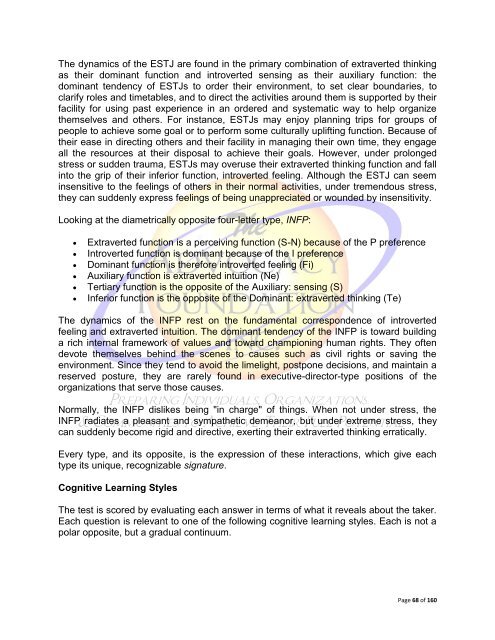The Gift of Introversion
The Gift of Introversion
The Gift of Introversion
Create successful ePaper yourself
Turn your PDF publications into a flip-book with our unique Google optimized e-Paper software.
<strong>The</strong> dynamics <strong>of</strong> the ESTJ are found in the primary combination <strong>of</strong> extraverted thinking<br />
as their dominant function and introverted sensing as their auxiliary function: the<br />
dominant tendency <strong>of</strong> ESTJs to order their environment, to set clear boundaries, to<br />
clarify roles and timetables, and to direct the activities around them is supported by their<br />
facility for using past experience in an ordered and systematic way to help organize<br />
themselves and others. For instance, ESTJs may enjoy planning trips for groups <strong>of</strong><br />
people to achieve some goal or to perform some culturally uplifting function. Because <strong>of</strong><br />
their ease in directing others and their facility in managing their own time, they engage<br />
all the resources at their disposal to achieve their goals. However, under prolonged<br />
stress or sudden trauma, ESTJs may overuse their extraverted thinking function and fall<br />
into the grip <strong>of</strong> their inferior function, introverted feeling. Although the ESTJ can seem<br />
insensitive to the feelings <strong>of</strong> others in their normal activities, under tremendous stress,<br />
they can suddenly express feelings <strong>of</strong> being unappreciated or wounded by insensitivity.<br />
Looking at the diametrically opposite four-letter type, INFP:<br />
<br />
<br />
<br />
<br />
<br />
<br />
Extraverted function is a perceiving function (S-N) because <strong>of</strong> the P preference<br />
Introverted function is dominant because <strong>of</strong> the I preference<br />
Dominant function is therefore introverted feeling (Fi)<br />
Auxiliary function is extraverted intuition (Ne)<br />
Tertiary function is the opposite <strong>of</strong> the Auxiliary: sensing (S)<br />
Inferior function is the opposite <strong>of</strong> the Dominant: extraverted thinking (Te)<br />
<strong>The</strong> dynamics <strong>of</strong> the INFP rest on the fundamental correspondence <strong>of</strong> introverted<br />
feeling and extraverted intuition. <strong>The</strong> dominant tendency <strong>of</strong> the INFP is toward building<br />
a rich internal framework <strong>of</strong> values and toward championing human rights. <strong>The</strong>y <strong>of</strong>ten<br />
devote themselves behind the scenes to causes such as civil rights or saving the<br />
environment. Since they tend to avoid the limelight, postpone decisions, and maintain a<br />
reserved posture, they are rarely found in executive-director-type positions <strong>of</strong> the<br />
organizations that serve those causes.<br />
Normally, the INFP dislikes being "in charge" <strong>of</strong> things. When not under stress, the<br />
INFP radiates a pleasant and sympathetic demeanor, but under extreme stress, they<br />
can suddenly become rigid and directive, exerting their extraverted thinking erratically.<br />
Every type, and its opposite, is the expression <strong>of</strong> these interactions, which give each<br />
type its unique, recognizable signature.<br />
Cognitive Learning Styles<br />
<strong>The</strong> test is scored by evaluating each answer in terms <strong>of</strong> what it reveals about the taker.<br />
Each question is relevant to one <strong>of</strong> the following cognitive learning styles. Each is not a<br />
polar opposite, but a gradual continuum.<br />
Page 68 <strong>of</strong> 160

















